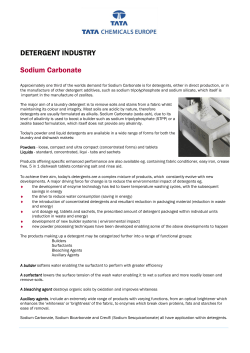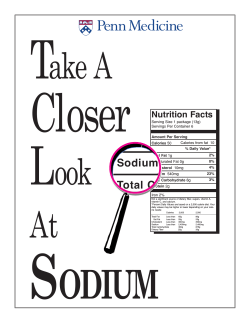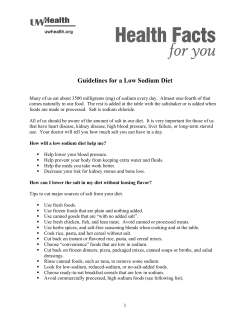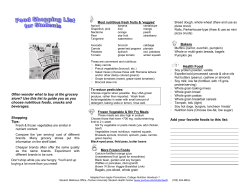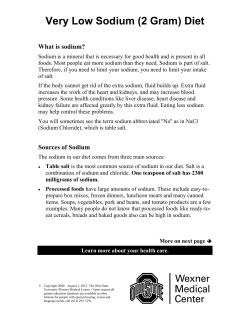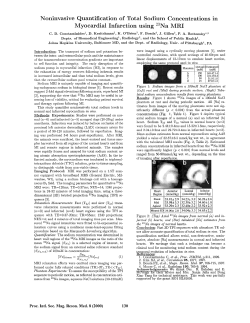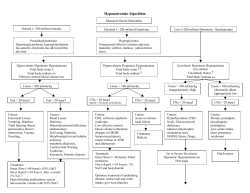
Following a 2 gram sodium diet ⅓
Following a 2 gram sodium diet Your health care provider has asked you to follow a “2 gram sodium” diet. This is a diet that moderately restricts the amount of sodium you eat. About ⅓ of the sodium in our diet comes from salt. But you must also watch out for other foods high in sodium, not just salt. On this diet, you need to limit your sodium intake to 2 grams (or 2,000 milligrams, abbreviated as 2,000 mg.) a day. Just one teaspoon of salt contains 2,300 mg. of sodium. What is sodium? Sodium is an important mineral found in almost all our food and drinks. Our bodies need only about 200 milligrams of sodium a day. But most Americans take in much more – from 10 to 35 times this amount! Why should I limit the sodium in my diet? In some people, too much sodium can cause the body to retain fluid. More fluid means the heart must work harder to pump blood. Extra fluid can also lead to swelling or “edema.” For people with high blood pressure, the extra fluid caused by a lot of sodium in the diet can make the blood pressure hard to control, even with medication. For people with heart failure, too much fluid puts a strain on the heart. Where does sodium come from? About ⅓ of the sodium in the diet of most Americans comes from salt. This includes the salt that is added in cooking, as well as salt added to food at the table. Salt is 40% sodium and 60% chloride. At least another ⅓ of most people’s sodium intake comes from processed foods (see list below). The rest of the sodium in our diet comes from water and other food. Processed foods include: fast foods “convenience foods” like frozen dinners or snacks canned food (except canned fruit) condiments such as ketchup and pickles cheese soup May I use any table salt at all? Remember, just one teaspoon of table salt contains 2,300 mg. of sodium – more than you are allowed in a day. So it is really important that you learn to enjoy foods without adding any salt at all – either before, during, or after cooking. This may not be easy at first, but try to experiment with the wide variety of herbs and spices that are allowed. (See the attached chart for some ideas.) With some patience and creativity, you can discover new ways to flavor food that are both interesting and good for you! 1 How do I follow a healthy, 2 gram sodium diet? Staying away from sodium is just one part of a healthy diet. Healthy eating also means limiting fat, sugar, and alcohol in your diet, and eating foods with fiber. You should eat a variety of different foods every day, including selections of: meat, poultry, fish, and meat substitutes breads and grains fruits and vegetables dairy products Use the attached chart to help you decide which of these foods, and how much of each type, you should eat. What about food labels? It is important that you read and understand food labels. Otherwise, you could be eating a lot of sodium and not know it. For some foods, the actual milligrams of sodium may be given, as in the box shown on the right. It shows that for every serving of granola, there are 95 milligrams of sodium. A serving in this case is one ounce. If you eat more than one ounce of granola, you will be getting more than 95 milligrams of sodium. Granola cereal: nutrition facts Serving size 1 oz. (2 TBS) Servings per package 16 Calories 130 Protein 3 grams Carbohydrates 16 grams Fat 6 grams 95 milligrams Sodium You can also find “ingredients lists” on most foods. The ingredients are listed in order by weight. That is, the ingredients that are present in highest concentration are listed first. When reading ingredients lists, watch out for any ingredient that has “sodium,” “salt,” or “soda” as even part of its name. For example, the label below shows that this food has four different sodium ingredients. And “salt” is the fourth ingredient by weight. This product should not be eaten on your diet. If you often use a particular food that doesn’t give nutrition information on the label, write to the manufacturer. Ask for the sodium content per serving. Or ask your dietitian about the food. INGREDIENTS: Potatoes, vegetable oil, whey, salt, dried milk solids, sour cream, onion salt, monosodium glutamate, dried parsley, lactic acid, sodium citrate, artificial flavors If salt is listed last on the ingredients list, is this food okay? Not necessarily! If salt is listed last, it means the other ingredients in the food weigh more than the salt. But that doesn’t mean there is not a lot of sodium in the food. Ask your dietitian if this food is okay, or check the label to find the sodium content per serving. Foods containing 35 mg. of sodium or less per serving are okay to eat. Please use the attached chart for information on sodium content of various foods. 2 My food is advertised as “very low sodium.” What does this mean? The Food and Drug Administration has established the following standards for the use of specific food labels about sodium. Here are some guidelines to follow. Sodium free Less than 5 mg. sodium per serving Okay to use Very low sodium 35 mg. or less of sodium per serving Okay to use Low sodium 140 mg. or less of sodium per serving Use with caution Reduced sodium Sodium content is at least 75% less than the original product Most of these foods are still too high in sodium for you No salt added, or “without salt” Used if no salt has been added to a product normally processed with salt The food may still contain a lot of sodium. Read the food label to check the sodium content. before eating. What about salt substitutes? Check with your doctor before using any salt substitutes. These products may contain a large amount of potassium or other ingredients your doctor may not want you to have. Using herbs and salt-free spices With some practice, you can learn to season your favorite foods without salt and still enjoy the taste. Experiment with the following seasonings, which you may use in any amount. To add flavor to a variety of foods, try: chopped/minced garlic garlic powder or onion powder (be sure it’s garlic or onion powder, not garlic or onion salt) fresh ground pepper spices such as thyme, oregano, basil, or parsley (use fresh whenever possible for even better flavor) 3 Season meat with: lemon juice bay leaf crushed red pepper rosemary For chicken try: sage seasoned vinegar ginger For potatoes: try chives instead of salt Using the “Food choice guidelines” Attached to this brochure you’ll find a chart that can help you make healthy food choices on a 2 gram sodium diet. You may want to pull out the chart and post it on your refrigerator. The first column lists the food type and the “recommended servings per day.” This is the number of servings of this food you need for healthy eating. The next column, “Lower sodium foods,” lists a lot of food choices that are low in sodium. Choose foods from this column for healthy eating on your diet. The far right column lists “High sodium foods.” You should avoid these foods altogether on your diet because they are too high in sodium. This material was prepared by clinicians from the department of nutrition services at Beth Israel Deaconess Medical Center. It is produced and distributed by The Beth Israel Deaconess Learning Center. ©2008, Beth Israel Deaconess Medical Center. All rights reserved. MC0872Rev. 4/07 4 Food choice guidelines: 2 gram sodium diet Food group, with recommended servings per day Lower sodium foods : Choose for healthy eating High sodium foods : Do not eat Fruits and vegetables Recommended servings: 2-4 servings fruit, 3-5 servings vegetables per day ♦ ♦ ♦ ♦ ♦ ♦ ♦ fresh, frozen, or canned fruit fruit juices fresh vegetables no-salt added canned vegetables frozen vegetables without sauces low-sodium V8® or tomato juice homemade vegetable sauce with allowed ingredients and no salt Dairy products Limit to 2 servings per day due to naturally-occurring sodium ♦ ♦ ♦ ♦ milk yogurt low-sodium cheese low-sodium cottage or ricotta cheese ♦ ♦ ♦ ♦ ♦ ♦ ♦ ♦ ♦ ♦ ♦ ♦ ♦ ♦ ♦ canned vegetables, canned baked beans tomato or V8® juice marinated or pickled vegetables sauerkraut pickles, olives, and relish Maraschino cherries potato mixes, such as instant mashed potato vegetables with cheese or sauce dried fruits containing sodium preservatives tomato sauce and puree spaghetti sauce (unless homemade with allowed ingredients and no salt) buttermilk, condensed milk, evaporated milk commercially prepared chocolate milk or milkshakes/frappes malted milk all other cheeses, including cheese spreads Breads and grains Recommended servings: 6-11 per day ♦ bread, English muffins, bagels, pita bread, tortillas - limit to 4 servings a day; one serving is 1 slice of bread, or ½ bagel or English muffin, or 1 small pita) low-sodium crackers & pretzels plain noodles, pasta & rice hot cereals (not instant) shredded wheat, puffed wheat, puffed rice, or other cereals with 35 mg. or less of sodium per serving other cereals (except bran, which is not allowed) – limit to ½ cup per day ♦ ♦ ♦ breads with salted tops salted crackers, including crackers with unsalted tops packaged convenience mixes, like Rice-a-Roni® or rice pilaf, pasta salad mixes, stuffing, boxed macaroni and cheese, casserole mixes instant hot cereal bran cereal “quick” baked goods made with baking powder or baking soda, including pancakes, waffles, biscuits, cornbread, muffins, banana bread, other sweet breads croutons self-rising flour cracker crumbs and commercial bread crumbs ♦ ♦ ♦ ♦ ♦ ♦ ♦ ♦ ♦ ♦ ♦ Food group, with recommended servings per day Lower sodium foods : Choose for healthy eating High sodium foods : Do not eat Meat, poultry, fish, and meat substitutes Recommended servings: 5-7 ounces per day ♦ ♦ ♦ ♦ ♦ ♦ ♦ ♦ ♦ ♦ Desserts and snacks Limit to 2 servings a day. ♦ ♦ ♦ Soups ♦ ♦ ♦ Seasonings and condiments, fats, beverages and other foods ♦ ♦ ♦ ♦ ♦ ♦ ♦ fresh beef, veal, pork, lamb, chicken, turkey, or fish eggs, but limit to four per week low-salt peanut butter dried beans, peas, and lentils low-sodium canned tuna, salmon, and sardines reduced sodium frozen dinners, if sodium is less than 500 mg. fresh tofu sherbet, sorbet, fruit ice, Jell-O®, popsicles ice cream, custard, ice milk, or frozen yogurt (limit to ½ cup per day) unsalted nuts, popcorns, pretzels, and chips homemade pies, made without salt low-sodium commercially canned & dehydrated soup, broth, bouillon homemade soups prepared with allowed ingredients and without salt herbs and spices with no salt; use fresh when possible for best flavor salt-free seasonings, such as Mrs. Dash® vegetable oils such as corn, soy, canola, olive oil vinegar sour cream unsalted butter, margarine, or mayonnaise regular butter, margarine, or mayonnaise (limit to a total of 4 teaspoons a day) ♦ ♦ ♦ ♦ ♦ ♦ ♦ ♦ ♦ ♦ ♦ ♦ ♦ ♦ ♦ ♦ kosher meat frozen, batter-dipped poultry and fish canned tuna and other fish, pickled herring, lox, caviar, anchovies, gefilte fish, sardines crabmeat, imitation seafood fast food, frozen dinners, and canned entrees deli meats, including cold cuts, reduced-sodium cold cuts, luncheon meats salted, smoked, canned, pickled, or dried meat, poultry, & fish chipped or dried beef, corned beef, pastrami, salami salted or fermented tofu regular hot dogs, bacon, sausage, Canadian bacon, ham, and salt pork regular peanut butter egg substitutes and pickled eggs canned beans, peas, or lentils commercially prepared or frozen desserts and bakery goods salted nuts, popcorn, pretzels, seeds, chips, party spreads, and dips cakes, cookies, brownies instant pudding mixes chocolate and caramel candies potato chips and crisps, potato sticks ♦ ♦ ♦ dried soup mixes canned soups, bouillon cubes, broth, consommé commercially prepared soups ♦ ♦ salt, Kosher salt commercial steak sauce, chili, and barbecue sauces, cooking wine, Worcestershire sauce commercially prepared sauces, gravies, or gravy/sauce mixes croutons salad dressing (unless low-sodium, with 35 mg. sodium or less per serving) ketchup, mustard, meat tenderizers, tartar sauce, relish, prepared horseradish, salsa, hot sauce any seasoning containing salt or sodium, such as garlic salt, onion salt, celery salt, lemon pepper, bacon bits, bacon grease, Teriyaki sauce soy sauce, MSG, Accent® Gatorade® baking soda, baking powder, self-rising flour instant cocoa mixes, Dutch process cocoa softened water used for drinking or cooking ♦ ♦ ♦ ♦ ♦ ♦ ♦ ♦ ♦ ♦
© Copyright 2025



